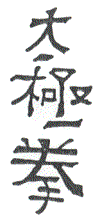


Rick J. Krause
4535 NW 36th St
Okahoma City, OK
(405)948-8504
Fundamentally, Tai Chi developed out of the tradition of therapeutic exercise in Asia, most notably in China and India.
In both cultures, history and archaeology indicate that well before the birth of Christ, these cultures had rich traditions of therapeutic exercise.
These traditions were and are to this day different in orientation from exercise science in the West. In Asia, exercise is typically combined with philosophical principles and a meditative frame of mind.
To see this, it is helpful to look at the meaning of the word "Tai Chi." This is a philosophical principle in Chinese culture which indicates the integration of Yin and Yang (or active and passive energies) such that a great harmony results.
This can be contrasted with the most common tradition of therapeutic exercise in India, Hatha Yoga. The words "Hatha Yoga" mean sun (ha) and moon (tha) yoked together in unity, indicating that the principles of Hatha Yoga and Tai Chi are very similar in concept.
There is no doubt, however, that as time went on, these exercise systems in China and India, respectively, developed some differences in character and emphasis. They have always retained, however, the use of similar philosophical ideas and an emphasis on meditative mindfulness.
About 500 A.D., legend has it that the first patriarch of Buddhism, called Ta Mo, visited China. At about that date, Ta Mo is considered to have arrived at Shaolim Temple in China from Northern India.
Reportedly, he found the monks to be unhealthy from lack of exercise, so he developed exercises that would promote their health. In China, a culture with frequently warring states, these exercises also developed martial qualities for self-defense.
Presumably, these exercise traditions of physical development based on philosophical ideas continued in the Chinese Shaolim Temple and in other Taoist termples until the 14th Century; a Taoist Monk, Chang San-Feng, developed the first true Tai Chi exercises.
One of the various stories that exist about the development of Tai Chi tells of Chang looking for an effective and spiritually acceptable martial art, with which he could travel safely through China. Supposedly, he was inspired by watching the movements of a snake and a crane fighting.
Although there is little historic certainty about these legends, they definitely indicate that the Taoists of this period in China developed a qualitatively different form of meditative health exercise which could also be used as an effective form of self-defense.
Historically, Tai Chi only became known and taught publicly (as opposed to being taught secretly in Taoist temples) in the 18th Century, when Yang Lu-Chan (1799- 1872) founded a school in Peking to teach Tai Chi openly to the public.
Yang had managed to learn his art from the Ch-en family, who had never previously taught anyone outside their own family. To this day, the Yang style is the most popular style of Tai Chi in the world.
Several other styles of Tai Chi, such as Wu, Sun, and Kuo, have also developed, and the original Ch-en style has evolved into a very widely practiced form of Tai Chi in China.
These Tai Chi styles are also complemented by related therapeutic movement arts, such as Pa Kua Chang, Hsing-I, Ch'uan, and Qi Gong.
These forms of exercise can be loosely called Tai Chi because they incorporate the philosophical principles mentioned above. Specifically speaking, the term Tai Chi is a philosophical term which means (as mentioned earlier) the great harmony or peace that results from following the way of balancing duality in life.
Americans and other Westerners have come to use Tai Chi as a generic term for Chinese internal health and martial arts. To be technically correct, however, the word "Ch'uan" or boxing martial arts, is used in the full name of this art, Tai Chi Chu'an.
Whatever it is called, Tai Chi continues to evolve from its mysterious beginning in Asia thousands of years ago.
Many people claim that the greatest masters of Tai Chi still live in China, but thousands of people all over the world are now practicing and developing Tai Chi. Some of them are practicing right here in Oklahoma City.






